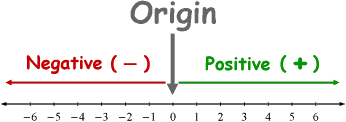Q. Define Number Line?
Ans.
A number line is a nice way to visualize and examine the ordering of the positive and negative numbers. Every positive and negative number that you can think of can be represented by a specific position on this number line.

The position in the middle is represented by zero, and is often referred to as the origin. The positive numbers are then listed to the right of the origin in increasing order. The negative numbers are the numbers listed to the left of the origin in decreasing order.
The set of numbers that is used to name the positions on the number line is called the set of integers. This set of integers is usually written out in the following way:
{..., -4, -3, -2, -1, 0, 1, 2, 3, 4, ...}
where "..." means that the numbers continue indefinitely.
(By the way, sets, or collections, of numbers are usually written using curly braces "{ , }" as I just did.)